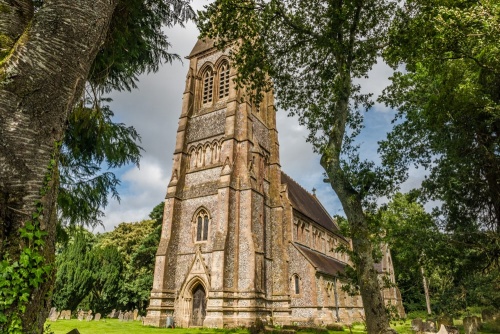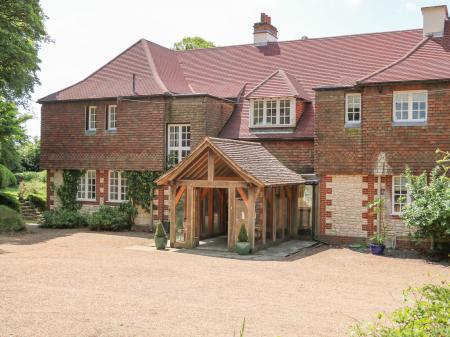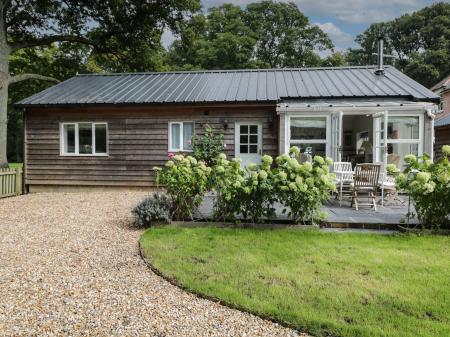
History
The church was begun in 1876 by Victorian Gothic architect Sir Arthur W Blomfield for Sir William Nicholson, a successful gin distiller. Blomfield's creation is an impressive building in Early English style, formed of a chancel, nave, transepts, and north and south aisles, with a soaring tower and spire which rises to 160 feet, making it the second-tallest church in Hampshire after St Saviour's in Southampton.
On the north side of the tower is a carved figure believed to represent the Bishop of Winchester, who consecrated the church in 1878.
The interior is lushly furnished, with the chancel, in particular, being lavishly decorated. The walls are of warm-toned Ham Hill stone, layered in bands with cream-coloured Bath stone. Marble mosaic floors run throughout the church, and are especially colourful in the chancel. Purbeck marble shafts are used to add still more colour to the chancel.

The altar is set upon a dais reached by seven steps of black Belgian marble. The altar is backed by a quite splendid reredos covering the entire east wall, built partly of Caen stone. The overall effect is one of splendour and rich colour.
The church cost ã22,000, which translates into something like ã2.6 million in today's money.
The church fell out of use in the 1970s and is now in the care of the Churches Conservation Trust.

Sir Arthur Blomfield
Arthur Blomfield was the fourth son of the Bishop of London and was born at Fulham Palace, the bishop's home.
His family connections were no doubt of great use in his architectural career. He specialised in restoring old churches and designing new ones. One of the junior architects at Blomfield's practice was Thomas Hardy, who, after a brief career in architecture, found fame as a novelist.
Apart from ecclesiastical buildings, Blomfield is known for the Royal College of Music and Selwyn College at the University of Cambridge.

Architecture
Here at Privett, Blomfield designed an extraordinary building in the Early English style, and we are fortunate that it has remained largely unaltered since it was built. To execute his designs, he used the Dove Brothers firm from Islington, London. Blomfield designed many of the furnishings and selected craftsmen best equipped to execute his vision.
The carving, including the beautifully-carved reredos, was by Farmer and Brindley, architectural sculptors from Lambeth, and the stained glass by Heaton, Butler, and Bayne, who had studios at Covent Garden in London and who also executed glass for Peterborough Cathedral and Westminster Abbey.

The Nicholson Family
J&W Nicholson and Co. was a family firm of distillers based in east London. Founded in 1802, the firm was famous for its brand of London Dry Gin. The success of the family business provided William Nicholson with the money he needed to buy the Basing Park estate in 1863. Over the next three decades, Nicholson transformed his estate, building housing for estate workers and introducing social reforms.
As you exit the church, take a moment to examine the Privett Centre next door. This Grade II listed building was one of those erected by William Nicholson. It was built in 1867 as a combination church school and master's house.
His efforts were not universally appreciated; the soaring spire of Privett church was dubbed, 'Nicholson's fire escape to heaven from the flames of hell.' If that seems harsh, remember that the gin that provided Nicholson's wealth was blamed for many of the ills that afflicted the labouring classes, particularly in larger cities, where alcoholism was rampant and gin was the cheap drink of choice.
William Nicholson was an avid cricketer and loaned the MCC money to buy the freehold of Lord's cricket ground in London. In gratitude, the MCC adopted as their colours the same yellow and red used on Nicholson's gin. The interior of Privett church also uses yellow and red stone; another nod to the source of the family's fortune. The yellow is provided by Ham Hill stone, a honey-toned limestone found only near Yeovil. The red is from Pink Corsehill stone.

A Tragic Fall
Several Nicholsons are remembered by monuments within the church. Perhaps the most poignant is the memorial in the south aisle to Godfrey Maule Nicholson, who died in 1901 when attempting to rescue a workman in his employ. The tragic incident occurred at the Three Mills Distillery in Bromley-by-Bow, London, when Nicholson and three other men opened an old well.
The first man descended a ladder to investigate the well. On climbing up again, he collapsed and fell back into the shaft. Nicholson climbed in after him and was overcome by noxious fumes. The other two workmen followed in a desperate attempt to save the first two men, but each, in turn, collapsed from the unknown fumes. Nicholson is interred in the churchyard.
Under the tower are memorials salvaged from the medieval church on this site. Included is a monument to Caroline Martineau, a sister of the Arctic explorer, Admiral Parry.
The lych gate is worth noting; it is a listed building in its own right. Tradition says that it was built using timbers from a ship used by Admiral Parry for an Arctic voyage of exploration. Given Parry's connection to Provett through his sister, this is not as far-fetched as it might seem.

Getting There
Holy Trinity Church is on Merepond Lane, beside the Privett Centre. Privett can be reached up a lane off the A272 about four miles west of Petersfield. There is parking along the road verge. The church was open when we visited and, to the best of our knowledge, is regularly open to visitors.









 We've 'tagged' this attraction information to help you find related historic attractions and learn more about major time periods mentioned.
We've 'tagged' this attraction information to help you find related historic attractions and learn more about major time periods mentioned.




